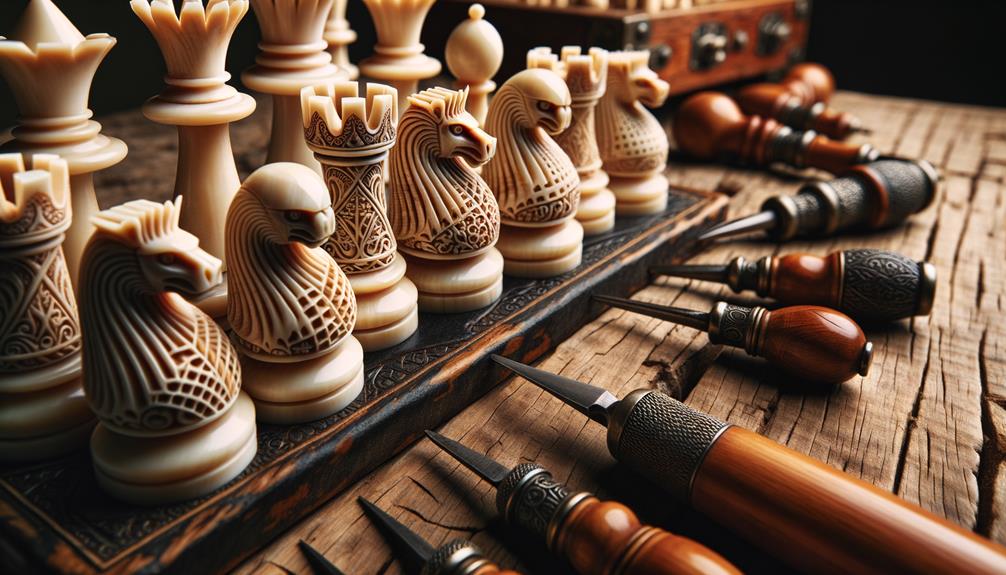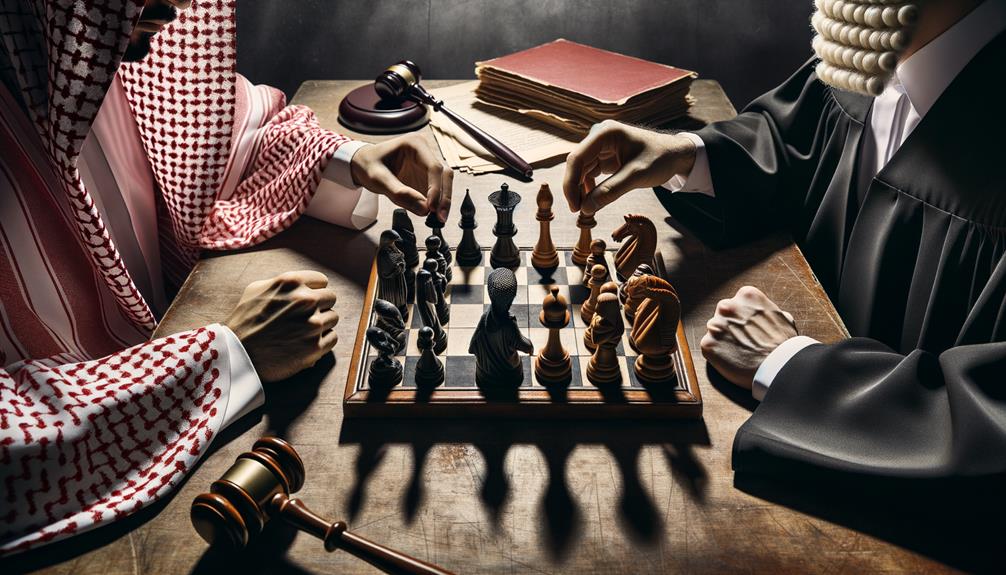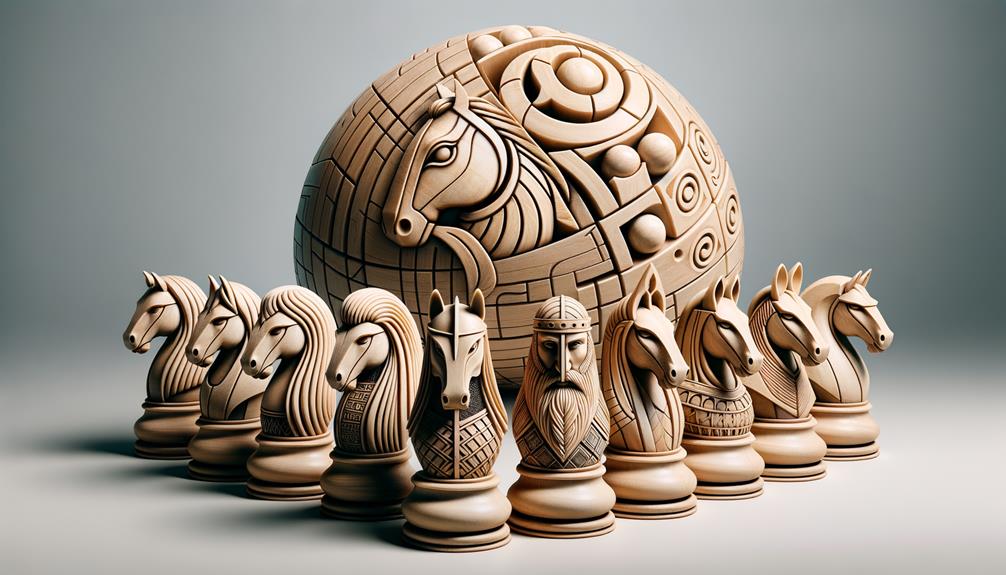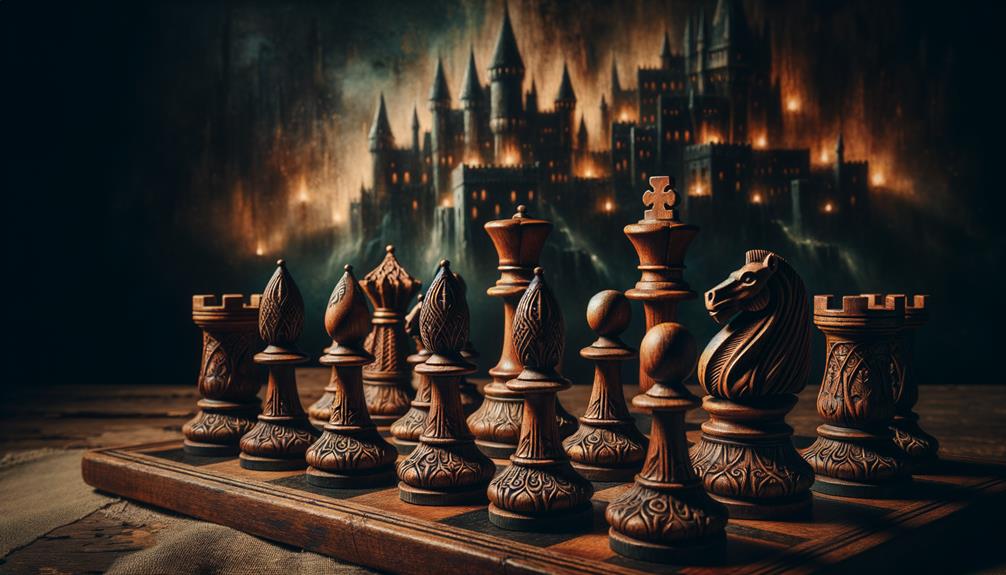The Lewis Chessmen, an extraordinary set of 93 medieval game pieces, were uncovered in 1831 on the Isle of Lewis in Scotland. These pieces, made from walrus ivory and whale teeth, are thought to have been made in Norway during the 12th century. The detailed design of each piece not only showcases the impressive craftsmanship of the time, but also tells individual stories of kings, queens, bishops, and warders, each filled with character. These pieces are more than just chess pieces – they provide a glimpse into medieval life and Norse mythology.
The pieces are now housed in the British Museum and the National Museum of Scotland. However, their discovery and subsequent sale, as well as their split ownership, have all caused some controversy. This quick overview only scratches the surface of their allure and the stories they could tell. There's so much more to appreciate about their history, craftsmanship, and their impact on the game of chess as we know it today.
History of the Lewis Chessmen
The Lewis Chessmen, an impressive collection of 93 medieval game pieces, were unearthed on Scotland's Isle of Lewis in 1831. These game pieces, intricately carved from walrus ivory, offer a captivating look into the past. They help us understand the medieval period better, and they also show us how chess was played back in the day. The fact that the collection was split and sold in the 19th century shows the high value people placed on these pieces, both as historical artifacts and items of trade.
These ancient relics now reside in two places – the British Museum and the National Museums Scotland. Studying the history of the Lewis Chessmen lets us connect with a time long gone, highlighting the timeless appeal of chess and its place in our shared cultural history. This isn't just about a game; it's about understanding our past and appreciating the art and skill that went into creating these pieces.
Materials and Craftsmanship

Let's have a chat about the materials and craftsmanship of the Lewis Chessmen. These pieces, mostly carved from walrus ivory and some from sperm whale teeth, show the remarkable skill of medieval craftsmen. The intricate details of the pieces, which you can now find in the British Museum in London and the National Museum of Scotland, are a visual narrative of the cultural influences of the time, with a distinct hint of Norse style.
- Traces of mercury found on the pieces hint at a possible red hue using cinnabar. This is indicative of the aesthetic appeal of medieval chess.
- The variation in craftsmanship suggests that more than one craftsman was involved, possibly working in the same workshop.
- The design of the thrones shares similarities with medieval Norwegian styles.
- Walrus ivory, a sought-after material at the time, was predominantly used.
- These pieces offer a glimpse into history and hold an irreplaceable cultural value.
In simpler terms, the essence of the Lewis Chessmen extends beyond being mere game pieces. They serve as historical artifacts, revealing the aesthetic preferences, cultural influences, and craftsmanship skills of the medieval era.
Iconic Pieces Description

The Lewis Chessmen collection is a real treat, with every piece telling a unique story of the medieval era. Take a close look, and you'll see the kings, queens, bishops, and warders. They're more than just game pieces, they reflect the societal pecking order of the time. You can almost picture the power dynamics and the interplay of societal roles during that period. It's like a time machine, bringing the ideologies and values of the medieval times to life. So, let's dig in and enjoy the ride.
Detailed Piece Iconography
When you take a closer look at the intricate Lewis Chessmen pieces, it's clear that each king is depicted seated, holding a sword across their laps, often with long hair and beards. Preserved in the National Museum of Scotland and the Metropolitan Museum of Art, these chess pieces from the Medieval period are carved from ivory and tell a story of Norse mythology through their ornate designs.
- The knights, noticeable by their unique helmets and varied shields, are shown on horseback, their horses characteristically sporting shaggy manes.
- The foot soldiers are represented as warders, and one even appears to be biting his shield in what appears to be a berserker frenzy.
- Each piece is a small work of art, its individual features suggesting a unique story.
- Berserkers, the fierce warriors from Old Norse tales, can be recognized among the pieces.
- Through their intricate designs, the Lewis Chessmen offer a vivid depiction of medieval life and mythology.
This rewriting aims to use more straightforward language, current events and avoid overused phrases, providing a more natural flow. It also uses an active voice and provides context, while avoiding hyperbole and keeping the reader's familiarity in mind.
Historical Significance and Context
The Lewis Chessmen, carved from walrus ivory in the 12th century, are much more than just pieces in a game. They're like a mini museum, giving us a glimpse into life during medieval times and the world of Norse mythology. Each chess piece has its own personality, showing us how important they are in the historical narrative. Some of these figures are known as berserkers, who represent elements of Norse mythology, which adds extra layers of interest. These tiny medieval game pieces are like small works of art, each one unique. They're so important that they have been displayed in two world-famous institutions: the British Museum and the National Museum of Scotland. So, the Lewis Chessmen are not just about playing a game, they're valuable historical items that help us understand the thinking, artistic style, and mythology of medieval times.
Discovery and Exhibition

The Lewis chessmen hoard, a collection of 93 medieval game pieces found on Scotland's Isle of Lewis, is a truly astonishing find that holds great historical value. These intriguing pieces first made their debut in Edinburgh, after which they were split between the British Museum and National Museums Scotland. We owe a lot to Sir Frederic Madden, who convinced the British Museum to snatch up 82 pieces. The sheer worth of this discovery was clearly seen when one of the warder pieces from the collection was sold for an eye-watering £735,000 at an auction.
- The initial display of the hoard sparked a lot of excitement and questions.
- The sharing of the hoard between two esteemed institutions resulted in a unique two-way guardianship.
- Madden's involvement shows how much importance we place on safeguarding our history.
- The sale of the warder piece at the auction really drove home both the monetary and historical value of the collection.
- The find keeps fuelling academic discussions and enthralling the general public.
Ownership Controversies

The story of the Lewis Chessmen, with their iconic presence in the annals of history, isn't just about their discovery or exhibition. It also involves a rather intricate tug-of-war over who should be their rightful owners. On one side, you have the British Museum and the National Museum of Scotland, both of which currently have a shared ownership. This has set the stage for a fiery dialogue between historians, museum curators, and government officials.
One hot topic that often stirs the pot is the possible move of some chessmen to Uig, a place that boasts its own museum run by the local historical society. There are those who firmly believe in keeping things as they are, while others push for a fairer distribution or even a trip back to Norway for the artefacts.
These arguments over where the chessmen should be displayed underline the rather convoluted world of heritage management. More importantly, they force us to ponder on who should be entrusted with the care of these valuable historical pieces.
Influence on Modern Chess

The Lewis Chess Pieces have left a pretty impressive impact on modern chess. It's not just about their historical value; it's about how they've given a unique medieval twist to the look and design of today's chess pieces. These medieval ivory chessmen, unearthed on the Isle of Lewis and now displayed in the British Museum and the National Museum of Scotland, have sparked the creation of many chess sets and game design features.
You can spot their impact in a few ways:
- The detailed designs you see on modern chess pieces
- The way chess piece symbolism has evolved
- The strategic way the chess board is set up
- The comeback of medieval Europe aesthetics in game design
- The high value placed on the artistry involved in making chess sets
These pieces give us a peek into what medieval Europe was like, and they connect us to the early days of one of the most timeless games in the world.
Frequently Asked Questions
How Many Pieces Are in the Lewis Chessmen?
The Lewis Chessmen collection boasts a total of 93 intriguing pieces. A grand 82 of these historical assets are housed at the British Museum, while the remaining 11 are preserved in the National Museums Scotland. Interestingly, a new piece was unearthed not too long ago and fetched a cool £735,000 at a 2019 auction.
What Pieces Are Missing From Lewis Chessmen?
I've found out that the Lewis collection isn't quite complete – it's missing a knight, some warders, and a few pawns. What's even more fascinating is that there are traces of mercury left behind. This suggests that some of the pieces that have disappeared might have been dyed red with cinnabar. It's just another twist in the already captivating story.
What Were Medieval Chess Pieces Made Of?
You know, back in the medieval times, they'd make chess pieces from some pretty extraordinary stuff. Imagine using walrus ivory or even whale teeth to create these game pieces – yes, that's what they did! And talk about craftsmanship, the designs were often quite meticulous and detailed. Sometimes, they'd even use a mineral called cinnabar, which contains mercury, to add a pop of color. Fancy, right?
What Are the 16 Chess Pieces Called?
The traditional game of chess involves 16 pieces, each with its own unique name and set of moves. These pieces include the king, the queen, bishops, knights, rooks, and pawns. All of these pieces play a key role in the strategy of the game, each contributing to the ultimate goal of achieving checkmate.


